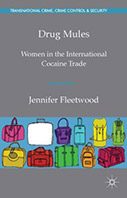Drug Mules: Women in the International Cocaine Trade

Author: Jennifer Fleetwood
Publisher: Basingstoke, UK; New York: Palgrave Macmillan, 2014. 208p.
Reviewer: Elaine Carey | March 2015
The docudrama, Locked Up Abroad has a television cult following. With titles such as “The Juggler Smuggler” and “Busted in Mexico,” many of the shows focus on the travails of “muling drugs” from one country to another. The arc of the storyline follows a young person who is approached by an unscrupulous trafficker offering an unsuspecting victim an all-expense paid holiday if he or she carries a package or two through controlled spaces, namely international airports or border crossings. Usually in the interviews, the mules acknowledge that the offer seemed suspect, but they asked few questions in order to enjoy a holiday in an “exotic” location. While these stories may seem all too familiar and almost mundane due to the repeated dramatization, Jennifer Fleetwood’s Drug Mules: Women in the International Cocaine Trade shows how complicated and multifaceted the work of modern drug mules has become. By way of a simple definition, a mule is someone who carries drugs across borders or controlled spaces for someone else.
Policy makers, journalists, and social scientists have theorized about the global criminal networks, the impact on democracy, and the economic consequences — the big questions. The more narrow studies, such as that of Fleetwood, often seem trivial or insignificant to the bigger issues. But ethnographic approaches demonstrate the scale and scope of the drug trade as it connects to the concrete and particular situations and responses that continually emerge, whether by the low-level workers, the drug traffickers, or the policing agents.
In this brief and accessible book, Fleetwood, a criminologist at the University of Leicester, unpacks the representations of women in the drug trade through her interviews with mules imprisoned in Ecuador. Women, she argues, are not simply powerless victims, but instead demonstrate agency even though they might be victimized within the trade. To understand the role of women, she interviewed mules who were imprisoned — many of whom welcomed a visitor willing to listen to their stories. Using the concepts of globalization and crime, Fleetwood analyzes gendered differences within the trade. She acknowledges that women are more likely than men to be employed in the illegal economy or on the fringes of the drug trade. By considering crime from an on the ground perspective, the author is seeking to look at the experiences of low-level workers in the drug trade.
Fleetwood’s use of case studies informs large-scale issues such as globalization and neoliberalism. She examines the changing geo-political implications of the United States on-going war on drugs, in which the United States government promised millions in security investments in exchange for an increase in arrests and drug confiscation. Her informants were arrested due to this increase in security and surveillance. While the U.S. drug war demonstrates the hubris of many politicians in the north, the increase in security, surveillance, and arrests occurred because Ecuadorian politicians and policing agents indeed met U.S. demands. Lower level actors in global policing such as police and customs officials play significant roles in the control of drug flows.
Mules, whether perceived as being on the fringes of the drug trade or not, play significant roles as global actors. There are multiple names for them: courier, swallower, body-packers, boleros, and burros, as well as mules. While women have historically been the mules of choice, Fleetwood recognizes that men actually comprise the majority of mules, and many sought and found employment as drug mules and couriers. Whether historically or currently, women usually carry drugs on or in their bodies or luggage. Men transport the same way, but they also are the ones who move large loads of drugs across borders and rivers in cars, trucks, and launches. Pilots and ship captains have long worked for drug traffickers and financiers. These highly skilled men are simply mules. The gendered segregated hierarchical work structures within “muling” represent a historical continuity of scale between different actors in the drug trade.
From her interviews, Fleetwood documented different approaches to crime and criminality. Moving drugs across an international border does not take any particular skill, and appears to be a victimless crime. Certain informants argued that muling was a preferable type of crime compared to prostitution, drug dealing, or fraud, while others had never committed a crime. They carried drugs for many reasons, and they described the traffickers who employed them as friends, boyfriends, husbands, or customers. They sought travel and excitement or they hoped to rectify a financial burden. Or, they thought that the trafficker loved them. Again, these are reasons that have echoed across time and place.
Fleetwood’s contribution to the growing field of drug studies is that mules are central players, and their descriptions of their work and their imprisonment offer new interpretations and questions for further research. While frequently perceived as victims, these men and women typically represented themselves as agents. They come from diverse ethnic, cultural, and class backgrounds. Moreover, men and women used different narrative ploys in recounting their lives in the drug trade. What is striking is that Fleetwood does not position these narrative ploys within the emerging narco-testimonials that have been published in Latin America. This might be because she focused on Ecuador, a country that has been perceived by scholars and policy-makers as a minor player in the drug trade.
Because of Fleetwood’s focus on Ecuador, however, her research represents a model for further work in countries that are transport sites in the global network of drugs. The author offers a compelling methodology and analysis about muling, but also about Ecuadorian policing and life in the prison system. While these themes are not the focus of the book, the eyewitness accounts of outsiders who are imprisoned and their perspectives on policing and the gendered prison system makes for interesting reading. This may inspire further criminological analysis of crime, prisons, and policing in countries where few scholars have studied. New approaches, such as Fleetwood’s, expand our knowledge of the multiple implications of the drug war, whether they be the life of the mule, of the policing agencies, or of the burgeoning prison populations in transport countries.
Elaine Carey, Associate Professor and Chairperson of the Department History, St. John’s University


